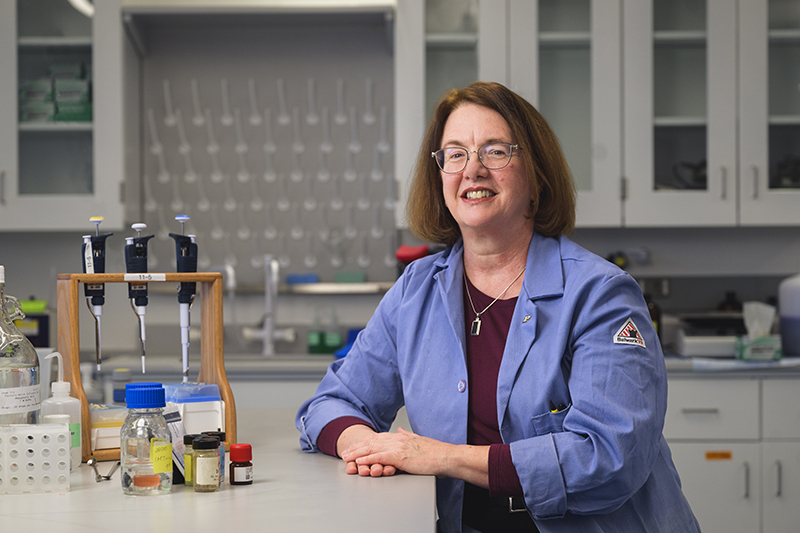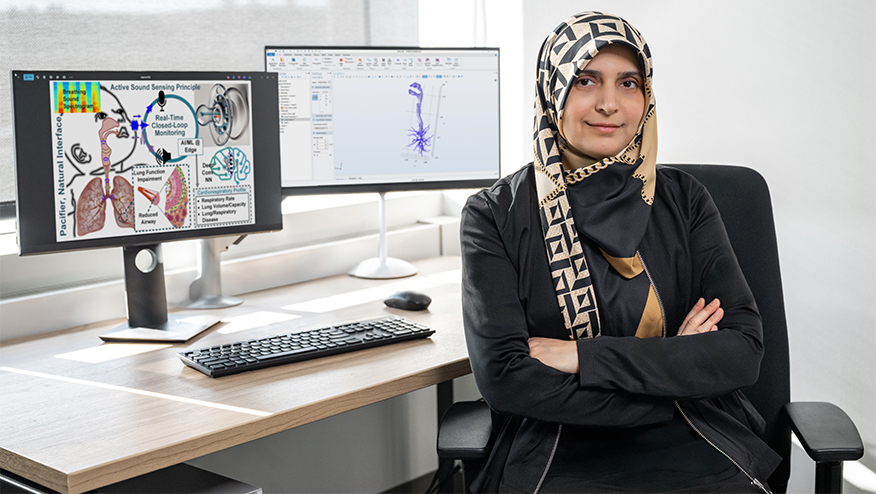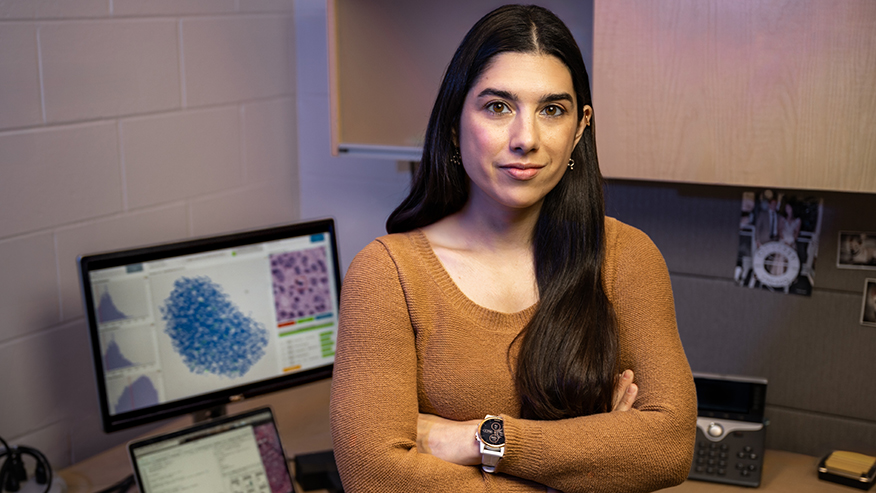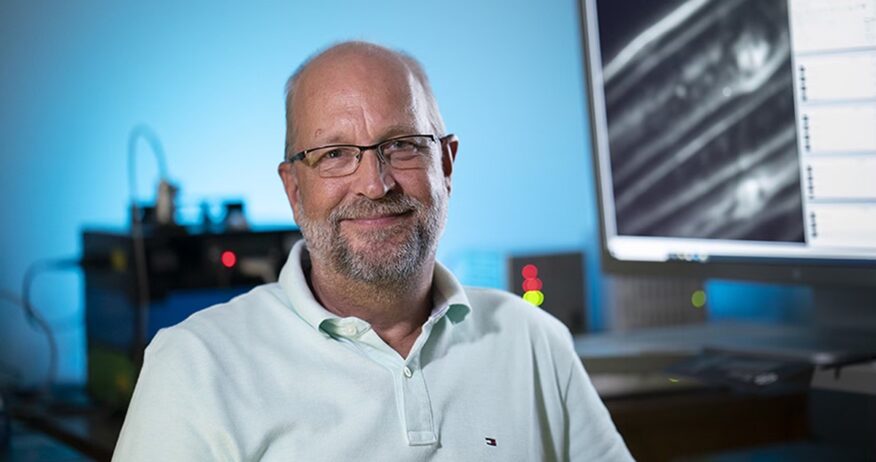Solid foundations for world-changing medicines and vaccines
Purdue scientist stabilizes pharmaceuticals to improve storage, stability and extend shelf life

Elizabeth Topp, a professor in the Department of Industrial and Molecular Pharmaceutics and the Davidson School of Chemical Engineering, as well as the director of the William D. and Sherry L. Young Advanced Manufacturing of Pharmaceuticals Institute at Purdue University, uses her expertise in chemistry to improve the shelf life and stability of pharmaceuticals. (Purdue University photo/Rebecca Robinos)
WEST LAFAYETTE, Ind. —
Pharmaceuticals are an important foundation of modern health and society. Without vaccines, medications and therapeutics, civilization as we know it would break down. And without careful formulation and storage, the pharmaceuticals themselves can break down and decay into uselessness.
Understanding and preventing that decay is the focus of Purdue scientist Elizabeth Topp’s career.
Topp, a professor in the Department of Industrial and Molecular Pharmaceutics and the Davidson School of Chemical Engineering, as well as the director of the William D. and Sherry L. Young Advanced Manufacturing of Pharmaceuticals Institute, is an expert on an unusual aspect of chemistry: solids.
The word “chemistry” may conjure up images of scientists swirling fluids together in a beaker, mixing them to form something new. But chemistry is not limited to liquid or gaseous states. Solids also undergo chemical reactions and change over time. Knowledge of that process is vital to understanding the way medication moves through the human body and how it should be stored.
Additional Information
“I get to do chemistry in this unusual state of matter,” Topp said. “Not many scientists do chemistry in solids. I’m interested in how reactions happen in the amorphous solid state, how we can understand and use those interactions to make better and more stable drug products.”
Many drug products are solids for most of their existence, from the conclusion of manufacturing, through their time on the shelf, which can last several years, right up until they enter a patient’s body. Understanding chemical degradation in the solid state helps ensure that the drug is intact when it reaches the patient. Keeping drugs in a solid state is useful; molecules move more slowly in solids than in liquids or gases, which slows down most types of degradation. The absence of water in a solid powder can be enough to slow down or even eliminate degradation, because many chemical reactions involved in breaking down drug components require water.
Messenger ribonucleic acid (mRNA) has been used for some of the most revolutionary recent drug developments, including the first COVID-19 vaccines. But mRNA breaks down very easily, so careful handling is required. Deeper understanding of that decay can keep drugs and vaccines stable longer, enabling them to reach and help more people.
“If you look at the structure of mRNA, it’s set up to fall apart,” Topp said. “When we’re trying to use it for things like vaccines and pharmaceuticals, we have to figure out how to keep that from happening from the end of vaccine manufacturing until it’s given to the patient. The current COVID mRNA vaccines are frozen solids — essentially ice kept at very low temperatures. My collaborators and I are exploring other types of solids that might not need such low temperatures. We’re also looking at ways to temporarily change the mRNA chemical structure to keep it from degrading in the vial, then have it revert to its native form in the body.”
In substances that rely on mRNA, like vaccines, scientists have discovered that the sensitive mRNA molecules must be encased in a fatty coating called a lipid nanoparticle to enter cells. Like an eggshell around an egg, these lipid nanoparticles help protect the mRNA and enable it to enter the patient’s cells. The lipid nanoparticles begin to break down and release mRNA. Like the fats in milk, which are solids but too small to see individually, the vaccine consists of thousands of these tiny lipid balls that protect and deliver the mRNA payload.
The breakdown of lipid nanoparticles can also occur as mRNA-based drugs are shipped around the world. The exposed mRNA breaks down more rapidly, and both the lipid nanoparticles and their mRNA payload are compromised. If both aren’t intact, the vaccine won’t work. Controlling how those chemical and physical changes occur, and when, is the art of drug stability.
“I’m asked all the time, ‘Why don’t we make drug molecules that don’t fall apart?’” Topp said. “Well, we do have those. They’re forever molecules, like DDT, and they’re often harmful. We really want pharmaceuticals to fall apart and biodegrade eventually. We don’t want them to live in our cells and tissues forever. We want them to do their job and then go away — to be metabolized and excreted from the body, and then to degrade to harmless byproducts in the environment. To me, pharmaceuticals are interesting in part because they’re transient, unstable. If a flower lasts forever, it’s plastic. Something about the beauty of the actual flower has been lost.”
Drugs are not magic. Simply assembling the correct active ingredients in a drug isn’t enough. Delivering the drug, intact and functional, to the correct site in the body at the right time is vital to treating patients and preventing disease.
“When you’re talking about drug formulations and drug products, the drug molecule is like the diva in an opera,” Topp said. “You have to keep her happy. If she’s not happy, it doesn’t matter what else you do. She’s not going to sing for you.”
This work is part of Purdue’s One Health initiative.
About Purdue University
Purdue University is a public research institution demonstrating excellence at scale. Ranked among top 10 public universities and with two colleges in the top four in the United States, Purdue discovers and disseminates knowledge with a quality and at a scale second to none. More than 105,000 students study at Purdue across modalities and locations, including nearly 50,000 in person on the West Lafayette campus. Committed to affordability and accessibility, Purdue’s main campus has frozen tuition 13 years in a row. See how Purdue never stops in the persistent pursuit of the next giant leap — including its first comprehensive urban campus in Indianapolis, the new Mitchell E. Daniels, Jr. School of Business, and Purdue Computes — at https://www.purdue.edu/president/strategic-initiatives.
Writer/Media contact: Brittany Steff, bsteff@purdue.edu
Source: Elizabeth Topp, topp@purdue.edu



